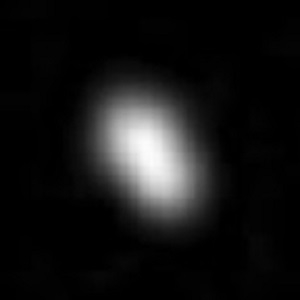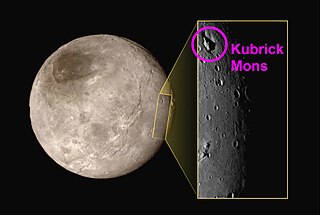
Pluto is a dwarf planet in the Kuiper belt, a ring of bodies beyond the orbit of Neptune. It is the ninth-largest and tenth-most-massive known object to directly orbit the Sun. It is the largest known trans-Neptunian object by volume, by a small margin, but is less massive than Eris. Like other Kuiper belt objects, Pluto is made primarily of ice and rock and is much smaller than the inner planets. Pluto has roughly one-sixth the mass of Earth's moon, and one-third its volume.

Charon, known as (134340) Pluto I, is the largest of the five known natural satellites of the dwarf planet Pluto. It has a mean radius of 606 km (377 mi). Charon is the sixth-largest known trans-Neptunian object after Pluto, Eris, Haumea, Makemake, and Gonggong. It was discovered in 1978 at the United States Naval Observatory in Washington, D.C., using photographic plates taken at the United States Naval Observatory Flagstaff Station (NOFS).

Eugene Merle Shoemaker was an American geologist. He co-discovered Comet Shoemaker–Levy 9 with his wife Carolyn S. Shoemaker and David H. Levy. This comet hit Jupiter in July 1994: the impact was televised around the world. Shoemaker also studied terrestrial craters, such as Barringer Meteor Crater in Arizona, and along with Edward Chao provided the first conclusive evidence of its origin as an impact crater. He was also the first director of the United States Geological Survey's Astrogeology Research Program.

Planetary geology, alternatively known as astrogeology or exogeology, is a planetary science discipline concerned with the geology of celestial bodies such as planets and their moons, asteroids, comets, and meteorites. Although the geo- prefix typically indicates topics of or relating to Earth, planetary geology is named as such for historical and convenience reasons; due to the types of investigations involved, it is closely linked with Earth-based geology. These investigations are centered around the composition, structure, processes, and history of a celestial body.

Nix is a natural satellite of Pluto, with a diameter of 49.8 km (30.9 mi) across its longest dimension. It was discovered along with Pluto's outermost moon Hydra on 15 May 2005 by astronomers using the Hubble Space Telescope, and was named after Nyx, the Greek goddess of the night. Nix is the third moon of Pluto by distance, orbiting between the moons Styx and Kerberos.

Hydra is a natural satellite of Pluto, with a diameter of approximately 51 km (32 mi) across its longest dimension. It is the second-largest moon of Pluto, being slightly larger than Nix. Hydra was discovered along with Nix by astronomers using the Hubble Space Telescope on 15 May 2005, and was named after the Hydra, the nine-headed underworld serpent in Greek mythology. By distance, Hydra is the fifth and outermost moon of Pluto, orbiting beyond Pluto's fourth moon Kerberos.

The dwarf planet Pluto has five natural satellites. In order of distance from Pluto, they are Charon, Styx, Nix, Kerberos, and Hydra. Charon, the largest, is mutually tidally locked with Pluto, and is massive enough that Pluto and Charon are sometimes considered a binary dwarf planet.

A dwarf planet is a small planetary-mass object that is in direct orbit around the Sun, massive enough to be gravitationally rounded, but insufficient to achieve orbital dominance like the eight classical planets of the Solar System. The prototypical dwarf planet is Pluto, which for decades was regarded as a planet before the "dwarf" concept was adopted in 2006.

Kerberos is a small natural satellite of Pluto, about 19 km (12 mi) in its longest dimension. Kerberos is also the second-smallest moon of Pluto, after Styx. It was the fourth moon of Pluto to be discovered and its existence was announced on 20 July 2011. It was imaged, along with Pluto and its four other moons, by the New Horizons spacecraft in July 2015. The first image of Kerberos from the flyby was released to the public on 22 October 2015.

Styx is a small natural satellite of Pluto whose discovery was announced on 11 July 2012. It was discovered by use of the Hubble Space Telescope, and is the smallest of the five known moons of Pluto. It was imaged along with Pluto and Pluto's other moons by the New Horizons spacecraft in July 2015, albeit poorly with only a single image of Styx obtained.

Belton Regio is a prominent surface feature of the dwarf planet Pluto. It is an elongated dark region along Pluto's equator, 2,990 km (1,860 mi) long and one of the darkest features on its surface.

Kubrick Mons is the name given to the largest of a series of mountain peaks on Pluto's moon Charon that rise out of depressions in the Vulcan Planitia region. The feature was first recorded by the Long Range Reconnaissance Imager (LORRI) aboard the New Horizons spacecraft during a flyby on 15 July 2015.

Vulcan Planitia, or Vulcan Planum, is the unofficial name given to a large plain on the southern hemisphere of Pluto's moon Charon. It discovered by New Horizons during its flyby of Pluto in July 2015. It is named after the fictional planet Vulcan in the science-fiction series Star Trek. The name is not approved by International Astronomical Union (IAU) as of 2024.

Vader is the unofficial name given to a dark crater on Pluto's largest moon Charon. The floor of Vader is darker than the surrounding terrain, covered in the same reddish-brown dark material that covers Mordor Macula on Charon's north pole. Though Charon's surface trends darker with increasing latitude, some craters, such as Vader, interrupt this trend. The crater was discovered by NASA's New Horizons space probe on its way by Pluto. It is named after the character Darth Vader from the Star Wars media franchise; the name has yet to be officially approved by the International Astronomical Union (IAU).

Organa is the informal name given to a crater on Pluto's largest moon, Charon. The crater was discovered by NASA's New Horizons space probe on its flyby of Pluto. The name was chosen as a reference to Leia Organa from the Star Wars media franchise, which keeps with the theme of naming Charon's craters after science fiction characters. Organa crater is rich in frozen ammonia, which suggests it was created very recently. This crater is located in the northern Pluto-facing hemisphere of Charon.

Nasreddin is a crater on Pluto's largest moon, Charon. The crater was first observed by NASA's New Horizons space probe on its flyby of Pluto in 2015. The name was chosen as a reference to Nasreddin, the hero of humorous folktales told throughout the Middle East, Southern Europe, and parts of Asia. The name was officially approved by the International Astronomical Union (IAU) on 11 April 2018.

Serenity Chasma is the unofficial name given to a large pull-apart fault on Pluto's moon, Charon. It is part of a series of faults that run along the perimeter of Vulcan Planum. It was discovered by the New Horizons mission, and informally named after the fictitious spaceship, Serenity.

Dorothy is the largest known impact basin on Pluto's moon Charon. The crater was discovered by the New Horizons space probe in 2015 during its flyby of Pluto and its moons. It was named after Dorothy Gale from the novel The Wonderful Wizard of Oz. The crater is located near Charon's north pole, and overlaps the edge of Mordor Macula.
Kelsi N. Singer (born 1984) is an American planetary scientist who is a senior research scientist at the Southwest Research Institute (SwRI) in Boulder, CO. She is a co-investigator and deputy project scientist of NASA's New Horizons mission studying the geomorphology and geophysics of the Pluto system and of Arrokoth (2014 MU69).

















